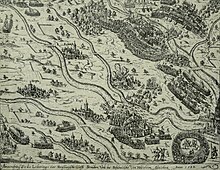Strasbourg Bishops' War
| Strasbourg Bishops' War | |||||
|---|---|---|---|---|---|
 Etching depicting skirmishes between Dachstein and Molsheim on 2 December 1592. |
|||||
|
|||||
| Belligerents | |||||
|
Strasbourg Anhalt-Bernburg |
|
||||
| Commanders and leaders | |||||
|
|
|
||||
The Strasbourg Bishops' War (German: Bischöflichen Krieg, French: Guerre des Evêques) (1592–1604) was a conflict between Protestants and Catholics for control of the Bishopric of Strasbourg. It was one of only two sectarian or confessional conflicts, both highly localised, that occurred within the Holy Roman Empire between the Peace of Augsburg (1555) and the outbreak of the Thirty Years' War (1618). It was less bloody than the Cologne War (1583–88). It coincided with the Counter-Reformation and the Spanish Winter (1598–99), and the Catholic victory caused Protestants in Germany great worry that the tide had turned decidedly against them.
The emergence of the Lutheran and Calvinist doctrines following the schism of Roman Catholic Church, soon led to the first large scale interdenominational conflict between those new creeds. The Schmalkaldic War ended in 1555 with signing of the Peace of Augsburg. The Free Imperial City of Strasbourg benefited from the treaty by gaining further autonomy, now being able to pursue its own ecclesiastical policies. Strasbourg's status as an important trading hub along with the appeal of its university, attracted radical thinkers from both sides of religious spectrum including Hans Denck, Girolamo Zanchi and Michael Servetus to name but a few. However, by the second half of the century the city started leaning towards Lutheranism under the leadership of Johann Marbach, a former doctoral student of Martin Luther. In his capacity as the President of the Company of Pastors, Marbach organized annual visitations to the 14 rural parishes under the city's control. The visitations included meetings during which catechisms were delivered, while the life and beliefs of every parishioner were publicly examined and those not in accord with the official doctrine were admonished.
...
Wikipedia
